A Hidden Rock Layer Beneath Bermuda Explains a Mysterious Swell in the Ocean's Crust








Senior leaders emphasize internal expertise and hands-on experimentation
The post Space Force uses AI challenge to push everyday use of artificial intelligence appeared first on SpaceNews.


Low Earth orbit is undergoing the fastest expansion in its history. However, the nature of the payload is changing. We are moving past simple “bent-pipe” communication relays — where a satellite simply receives a signal and beams it back to Earth without processing it. With initiatives like StarCloud deploying and training a large language model […]
The post Beyond the ground station: Why space data centers require a distributed RAID appeared first on SpaceNews.

NASA plans to test SpaceX’s Starshield satellite network, designed primarily for national security customers, to support operations of the agency’s Deep Space Network.
The post NASA to test SpaceX’s Starshield in pilot program appeared first on SpaceNews.

Palo Alto startup Apolink has picked GomSpace to build the radio frequency subsystem for its first relay cubesat, aiming to show how signals can be received from other LEO spacecraft and forwarded to the ground.
The post GomSpace to provide RF subsystem for Apolink LEO relay demonstrator appeared first on SpaceNews.

An international team of researchers has discovered a new mechanism that can trigger the formation of bubbles in magma – a major driver of volcanic eruptions. The finding could improve our understanding of volcanic hazards by improving models of magma flow through conduits beneath Earth’s surface.
Volcanic eruptions are thought to occur when magma deep within the Earth’s crust decompresses. This decompression allows volatile chemicals dissolved in the magma to escape in gaseous form, producing bubbles. The more bubbles there are in the viscous magma, the faster it will rise, until eventually it tears itself apart.
“This process can be likened to a bottle of sparkling water containing dissolved volatiles that exolve when the bottle is opened and the pressure is released,” explains Olivier Roche, a member of the volcanology team at the Magmas and Volcanoes Laboratory (LMV) at the Université Clermont Auvergne (UCA) in France and lead author of the study.
The new work, however, suggests that this explanation is incomplete. In their study, Roche and colleagues at UCA, the French National Research Institute for Sustainable Development (IRD), Brown University in the US and ETH Zurich in Switzerland began with the assumption that the mechanical energy in magma comes from the pressure gradient between the nucleus of a gas bubble and the ambient liquid. “However, mechanical energy may also be provided by shear stress in the magma when it is in motion,” Roche notes. “We therefore hypothesized that magma shearing forces could induce bubble nucleation too.”
To test their theory, the researchers reproduced the internal movements of magma in liquid polyethylene oxide saturated with carbon dioxide at 80°C. They then set up a device to observe bubble nucleation in situ while the material was experiencing shear stress. They found that the energy provided by viscous shear is large enough to trigger bubble formation – even if decompression isn’t present.
The effect, which the team calls shear-induced bubble nucleation, depends on the magma’s viscosity and on the amount of gas it contains. According to Roche, the presence of this effect could help researchers determine whether an eruption is likely to be explosive or effusive. “Understanding which mechanism is at play is fundamental for hazard assessment,” he says. “If many gas bubbles grow deep in the volcano conduit in a volatile-rich magma, for example, they can combine with each other and form larger bubbles that then open up degassing conduits connected to the surface.
“This process will lead to effusive eruptions, which is counterintuitive (but supported by some earlier observations),” he tells Physics World. “It calls for the development of new conduit flow models to predict eruptive style for given initial conditions (essentially volatile content) in the magma chamber.”
By integrating this mechanism into future predictive models, the researchers aim to develop tools that anticipate the intensity of eruptions better, allowing scientists and local authorities to improve the way they manage volcanic hazards.
Looking ahead, they are planning new shear experiments on liquids that contain solid particles, mimicking crystals that form in magma and are believed to facilitate bubble nucleation. In the longer term, they plan to study combinations of shear and compression, though Roche acknowledges that this “will be challenging technically”.
They report their present work in Science.
The post Will this volcano explode, or just ooze? A new mechanism could hold some answers appeared first on Physics World.

In this episode of Space Minds, host Mike Gruss sits down with Maj. Gen. Stephen Purdy, one of the U.S. Space Force’s most influential acquisition leaders and recipient of the SpaceNews Icon Award for Military Space Achievement.
The post Why the Space Force says 2025 changes everything appeared first on SpaceNews.

Two space companies have collaborated to demonstrate automated close approaches between spacecraft using a single camera as the primary sensor.
The post Starfish Space and Impulse Space demonstrate autonomous spacecraft proximity operations appeared first on SpaceNews.
Academics who switch to hybrid working and remote collaboration do less impactful research. That’s according to an analysis of how scientists’ collaboration networks and academic outputs evolved before, during and after the COVID-19 pandemic (arXiv: 2511.18481). It involved studying author data from the arXiv preprint repository and the online bibliographic catalogue OpenAlex.
To explore the geographic spread of collaboration networks, Sara Venturini from the Massachusetts Institute of Technology and colleagues looked at the average distance between the institutions of co-authors. They found that while the average distance between team members on publications increased from 2000 to 2021, there was a particularly sharp rise after 2022.
This pattern, the researchers claim, suggests that the pandemic led to scientists collaborating more often with geographically distant colleagues. They found consistent patterns when they separated papers related to COVID-19 from those in unrelated areas, suggesting the trend was not solely driven by research on COVID-19.
The researchers also examined how the number of citations a paper received within a year of publication changed with distance between the co-authors’ institutions. In general, as the average distance between collaborators increases, citations fall, the authors found.
They suggest that remote and hybrid working hampers research quality by reducing spontaneous, serendipitous in-person interactions that can lead to deep discussions and idea exchange.
Despite what the authors say is a “concerning decline” in citation impact, there are, however, benefits to increasing remote interactions. In particular, as the geography of collaboration networks increases, so too does international partnerships and authorship diversity.
Lingfei Wu, a computational social scientist at the University of Pittsburgh, who was not involved in the study, told Physics World that he was surprised by the finding that remote teams produce less impactful work.
“In our earlier research, we found that historically, remote collaborations tended to produce more impactful but less innovative work,” notes Wu. “For example, the Human Genome Project published in 2001 shows how large, geographically distributed teams can also deliver highly impactful science. One would expect the pandemic-era shift toward remote collaboration to increase impact rather than diminish it.”
Wu says his work suggests that remote work is effective for implementing ideas but less effective for generating them, indicating that scientists need a balance between remote and in-person interactions. “Use remote tools for efficient execution, but reserve in-person time for discussion, brainstorming, and informal exchange,” he adds.
The post Remote work expands collaboration networks but reduces research impact, study suggests appeared first on Physics World.
There are 12 questions in total: blue is your current question and white means unanswered, with green and red being right and wrong. Check your scores at the end – and why not test your colleagues too?
How did you do?
10–12 Top shot – congratulations, you’re the next John Hopfield
7–9 Strong skills – good, but not quite Nobel standard
4–6 Weak performance – should have asked ChatGPT
0–3 Worse than random – are you a bot?
The post How well do you know AI? Try our interactive quiz to find out appeared first on Physics World.

SAN FRANCISCO – University of California spinoff MetaSeismic wasn’t focused on space applications when it began using an artificial intelligence platform to create materials to mitigate vibration and shock. But […]
The post MetaSeismic material mitigates vibration and shock in NASA Marshall testing appeared first on SpaceNews.

This quiz was first published in February 2025. Now you can enjoy it in our new interactive quiz format and check your final score. There are 18 questions in total: blue is your current question and white means unanswered, with green and red being right and wrong.
The post International Year of Quantum Science and Technology quiz appeared first on Physics World.

A Rocket Lab Electron rocket successfully launched a technology demonstration satellite for JAXA Dec. 13 as the company reshuffles its launch manifest.
The post Rocket Lab launches JAXA tech demo satellite appeared first on SpaceNews.
